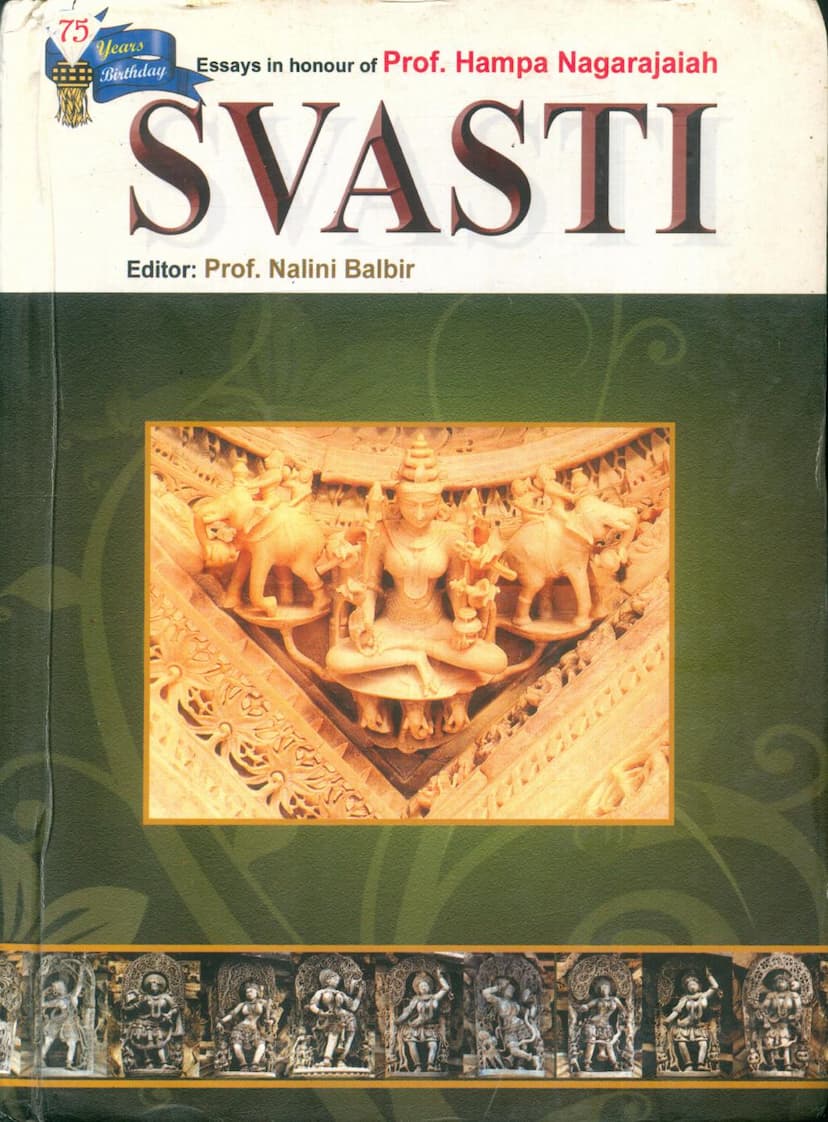Svasti
Added to library: September 2, 2025

Summary
Here is a comprehensive summary of the Jain text "Svasti: Essays in Honour of Prof. Hampa Nagarajaiah," based on the provided pages:
Book Title: Svasti: Essays in Honour of Prof. Hampa Nagarajaiah for his 75th Birthday Editor: Prof. Nalini Balbir Publisher: K.S. Muddappa Smaraka Trust
Overview: "Svasti" is a felicitation volume presented to Professor Hampa Nagarajaiah (popularly known as "Hampana") on the occasion of his 75th birthday. The book celebrates his significant contributions to Karnatak culture and Jain traditions. It comprises a collection of essays by scholars from India and abroad, covering a wide range of subjects related to Jainism, reflecting the diverse interests of Professor Nagarajaiah himself. The essays utilize various textual sources in Sanskrit, Prakrit, Apabhramsa, Kannada, Tamil, and Hindi.
Professor Hampa Nagarajaiah: Professor Nagarajaiah is described as a distinguished scholar and an enthusiastic personality. His academic career includes teaching at government colleges and later at Bangalore University, where he held positions from Lecturer to Professor until his retirement. He has also played significant roles in various institutions promoting Indian culture, particularly Kannada and Jain traditions, such as the Kannada Sahitya Parishat, the Jaina Research Centre, the Institute of Kannada Studies, the Department of Kannada and Culture, and the Jaina Research Institute. He is also recognized for his prolific writing, including books for children, for which he received a National Award. His work spans classical Kannada literature, epigraphy, architecture, linguistics, history, and religion.
Content of the Essays: The collection of essays is divided into five sections, covering a broad spectrum of Jain studies:
-
Section I: Epigraphy, Iconography, Manuscripts
- This section features essays on Jaina art as a source for Indian history, culture, and art, with a special focus on Kuṣāṇa images from Mathura.
- It includes new epigraphic evidence for early Jainism in Tamil Nadu, identification of Jaina images, Jaina inscriptions from Varanga (Karnataka), donation patterns to Jinalayas from Kannada inscriptions in Andhra Pradesh, selected Jaina Tri-kuta monuments from Karnataka, and the date of Vidyānanda.
- Other topics include rock-cut Jaina temples and inscriptions in Gwalior Fort, a 17th-century Digambara Yantra at the British Museum, and illustrations of the Bhaktāmara Stotra and observations on Western Indian Miniatures.
-
Section II: Literature
- This section delves into observations on the poetic style of the oldest Mahāvīra eulogy in the Sūyagaḍānga.
- It also includes remarks on the cultural history of the ear in India, Jaina narratives like the story of King Dandaka (Jaina Jatāyus), and discussions on dance and music in Jaina literature, with a special reference to Kannada literature.
- The paper "सिरिवालचरिउ एक दुर्लभ पाण्डुलिपि" (Sirivalcharu: A Rare Manuscript) by Rajaram Jain is included in this section, presented in its original Hindi.
-
Section III: Kundakunda and his legacy
- This section explores the philosophical contributions of Kundakunda, with essays on Kundakunda versus Sāmkhya on the soul, and a comparative study of the historical development of the Jaina Yoga system and the impact of other Yoga systems on it.
- It also includes an English adaptation of Acārya Akalanka's Svarūpasambodhana, titled "Addressing One's True Self," and observations on Banārasīdās's Karmachattīsī, a work consisting of thirty-six stanzas on Karma.
-
Section IV: General Issues
- This section covers a variety of general topics related to Jainism, including observations on Buddhist and Jaina ethics, the Jaina concept of the origin and transmission of speech (Bhāṣā).
- It also features discussions on the historical development of the Jaina Yoga system, Jaina devotionalism (focusing on the Namaskara Mantra), methods used by Mahāvīra for social change, models of conflict-resolution and peace in Jain tradition, humanism and Jainism, and Mahāprajña's contribution to Anekānta philosophy with its real-time applications.
-
Section V: Facets of contemporary Jainism
- This section focuses on contemporary aspects of Jainism, including perspectives on renunciation and pilgrimage in the Deccan.
- It features an analysis of the Gommateśvara's grand Mahāmastakābhiseka ritual through the lens of "aesthetics of religion" as a new research method for Jaina ritual studies.
- The section also includes discussions on the goddesses of Sravana Belgola, the "99fold" pilgrimage to Shatrunjaya as a case study of young women's embodiment of Jain tradition, and a quantitative study of the Terapanth Śvetāmbara mendicant order.
- Finally, it provides an overview of the Jains in Antwerp/Belgium.
Key Themes and Significance: The volume "Svasti" serves as a comprehensive tribute to Professor Hampa Nagarajaiah's extensive work and a testament to the vibrant and diverse field of Jain studies. The essays highlight the historical depth, philosophical richness, artistic expressions, and contemporary relevance of Jainism, covering various geographical regions and historical periods. The book underscores the importance of Jaina art, literature, philosophy, and practices in shaping the cultural landscape of India. The collection also emphasizes the ongoing research and scholarly interest in Jainism from around the world.
Overall Impression: "Svasti" is a significant scholarly work that honors a key figure in Jain studies and showcases the breadth and depth of research in the field. The essays reflect a commitment to understanding Jainism from multiple perspectives, including its historical development, its philosophical underpinnings, and its manifestations in contemporary life.